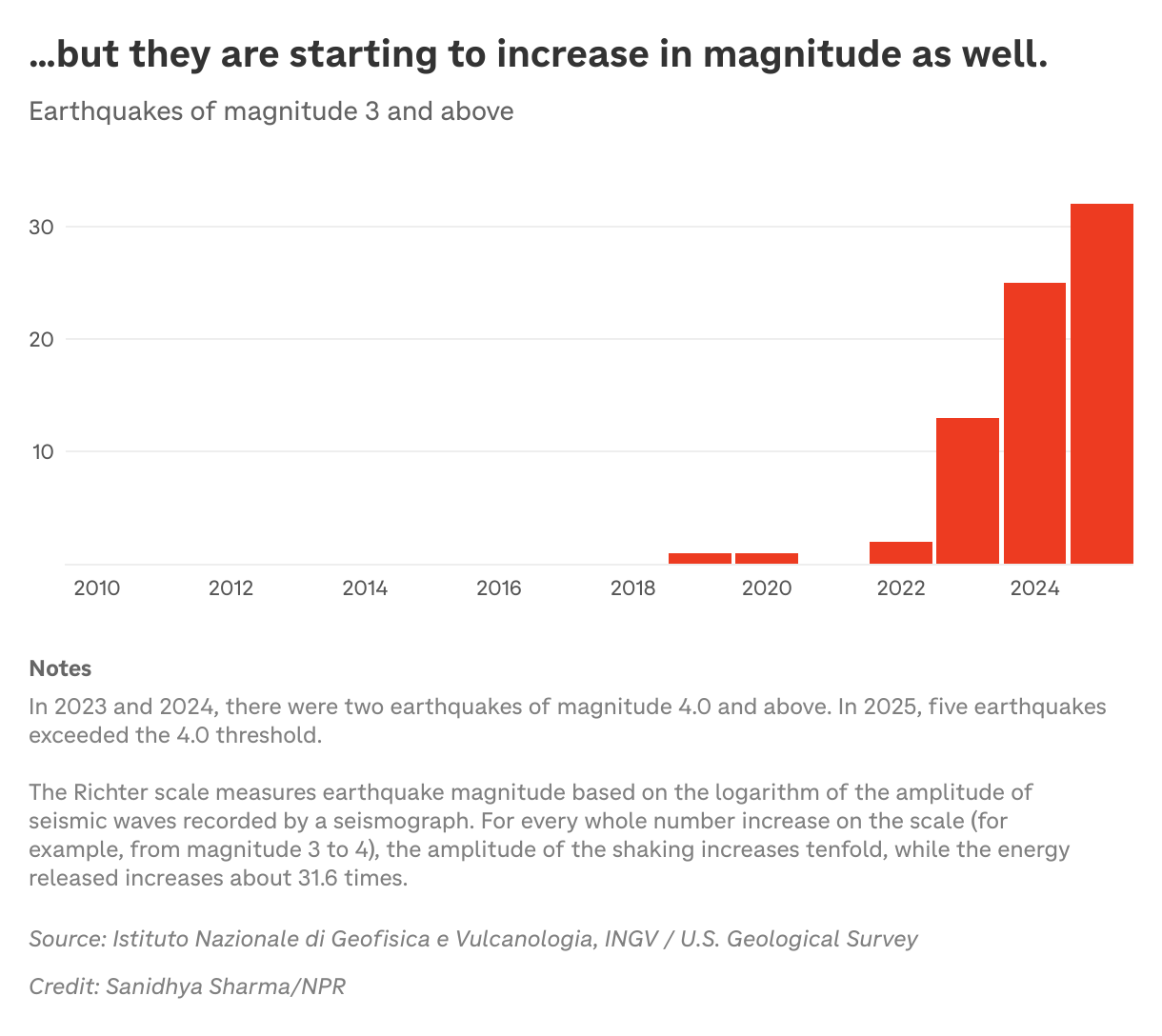
Aerial view of the densely inhabited space of Pozzuoli, positioned inside the Campi Flegrei volcanic space. Over half 1,000,000 folks reside on this area, which is repeatedly monitored because of the ongoing volcanic exercise.
Valerio Muscella for NPR
cover caption
toggle caption
Valerio Muscella for NPR
POZZUOLI, Italy — In Greek and Roman mythology, the Campi Flegrei volcano is depicted because the opening to the underworld.
Its prehistoric eruptions blocked out the solar, turning summer season into winter and protecting Europe and Russia in thick volcanic ash. Now this highly effective seismic large close to Naples is stirring once more, shaking the bottom in a approach that scientists say it hasn’t for hundreds of years.
“Two of the latest earthquakes are the strongest we have ever seen,” stated Giovanni Macedonio, the director of the Nationwide Institute of Geophysics and Volcanology in Naples. Earthquakes in March and June this yr brought on by the Campi Flegrei pressured folks “to evacuate and there are tens of households that may’t return to their properties due to the injury.”

Giovanni Macedonio (proper) is the director of the Nationwide Institute of Geophysics and Volcanology in Naples. He oversees the realm and screens seismic exercise from an observatory.
Valerio Muscella for NPR
cover caption
toggle caption
Valerio Muscella for NPR
For everybody to outlive an eruption, over half 1,000,000 folks must be evacuated from an space that Italian authorities have marked the “pink zone” across the Campi Flegrei’s eight-mile huge crater. Right here, Macedonio says, “there actually are not any countermeasures to guard your self” from the pyroclastic move of volcanic particles and ash — super-heated to some 1,472 levels Fahrenheit — that will cowl terrain at a velocity between 30 and 60 miles per hour.
The Campi Flegrei volcano is taken into account a “nationwide menace” for the “explosive” model of its eruptions, which, scientists imagine might create an eruptive column — a sort of cloud of mud and ash — that might rise some 18 miles into the sky and unfold on the wind. When that column of mud and ash ultimately falls, its weight may even collapse roofs of properties.
On the observatory Macedonio oversees in Naples, a big pink telephone connects on to the civil safety headquarters in Rome. The road is examined twice a day.

A pink telephone at an observatory monitoring seismic exercise in Naples connects on to the civil safety headquarters in Rome. The road is examined twice a day.
Valerio Muscella for NPR
cover caption
toggle caption
Valerio Muscella for NPR
Vesuvius — the very best identified volcano on this space, whose pyroclastic move froze in time the traditional Roman metropolis of Pompeii — rises to the east of Naples. Hans Christian Andersen, after witnessing an eruption in 1834, described the lava as “colossal, fallen stars.”
However the fact is it is the a lot much less seen Campi Flegrei, or Phlegrean Fields (from the Greek phlegraios for “fiery”), underground, that has the potential to be devastating. It is because immediately, tons of of 1000’s of individuals reside proper on prime of this volcano — within the eight-mile-wide crater left by previous eruptions.

The crater of the Solfatara with Mount Vesuvius within the background. The Solfatara crater of Pozzuoli and Mount Vesuvius are each a part of the Campanian volcanic system, though they belong to several types of volcanic buildings. Solfatara is a part of the Campi Flegrei caldera, identified for floor uplift, seismic exercise and degassing, whereas Vesuvius is a traditional cone volcano, well-known for its catastrophic eruption that destroyed Pompeii.
Valerio Muscella for NPR
cover caption
toggle caption
Valerio Muscella for NPR
“All of us know we live in a totally seismic space,” stated Naples resident Maddalena Desario, whose neighborhood is located on the rim of the Campi Flegrei caldera.
Within the historic metropolis of Pozzuoli, which sits within the caldera, vacationers observe a information by way of winding, slender alleyways. From a hilltop, they appear out over a curving bay — the ocean glowing within the sunshine beneath an intense blue sky, and the island of Capri, playground of the wealthy, within the distance.
However this immense magnificence belies the peril right here. Through the largest volcanic eruption, some 39,000 years in the past, the Campi Flegrei shot out 72 cubic miles of molten rock, based on Macedonio of the Nationwide Institute of Geophysics and Volcanology. World temperatures plummeted, and the whole lot of what’s now Europe, in addition to elements of Russia, had been lined in volcanic ash. Some scientists have suggested the eruption might have contributed to the ultimate disappearance of the Neanderthals.

Guests on a guided tour of the Rione Terra historic quarter in Pozzuoli look out onto the ocean.
Valerio Muscella for NPR
cover caption
toggle caption
Valerio Muscella for NPR
Consultants say an eruption immediately wouldn’t happen on that scale. Nevertheless, it might nonetheless be giant sufficient to wreak havoc on tens of millions of lives and halt air journey throughout Europe, maybe even additional across the globe. So Macedonio and his staff monitor its each grumble and tremor.
On the observatory in Naples, screens on each wall present the seismic exercise of all of the volcanoes within the area. On the day NPR visited in September, a loud alarm sounded throughout the room, signaling that an earthquake had been detected. The scientists moved quick to evaluate the placement and energy of the tremor and ship the data to the Italian public security authorities.
It was within the Campi Flegrei. And this isn’t uncommon. Final yr, the scientists logged some 2,500 earthquakes brought on by this volcano in a single month. And now the tremors are intensifying in magnitude: June noticed an unprecedented 4.6-magnitude earthquake — sufficient to crack partitions and ship folks fleeing from their properties.


These earthquakes are coupled with bradyseism — a phenomenon during which the bottom swells, slowly rising beneath folks’s toes. On the previous port in Pozzuoli, boats now stand nestled in lengthy grass, marooned on new land that has risen out of the ocean. Historic Roman columns have fossils of mollusks midway up, exhibiting how they had been as soon as underwater.

The columns of Pozzuoli’s Temple of Serapis have fossils of mollusks midway up, proof that they had been as soon as underwater.
Valerio Muscella for NPR
cover caption
toggle caption
Valerio Muscella for NPR
It is as if this large volcano had been respiration — the bottom rising and reducing over many years, with each breath. Earlier than a final main eruption some 15,000 years in the past, scientists say the bottom rose about 85 toes. Now it is steadily rising once more — up by 4.6 toes since 2005, and the speed at which it is swelling is getting sooner.
“One factor that you just study very quickly is that we shouldn’t have management. Nature has the management,” stated Warner Marzocchi, a professor of geophysics and pure danger on the College of Naples, Federico II. “These sort of volcanic programs are used to having phases of unrest like this one which we’re observing. The largest scientific problem is to grasp what’s driving this unrest.”
To fulfill that problem, Marzocchi and his staff — together with Stanford College and the Nationwide Institute of Geophysics and Volcanology — are utilizing synthetic intelligence to construct what they and different consultants say is probably the most correct image but. The mannequin identifies 1000’s of earthquakes not beforehand detectable with present know-how. The analysis expanded the total seismicity recorded by monitoring stations within the final three years from about 12,000 to greater than 54,000 earthquakes within the Campi Flegrei alone.
The developments assist scientists make extra educated guesses in regards to the probably magnitude of future quakes and study extra about why the Campi Flegrei has proven growing exercise since 2005. Marzocchi says the information recommend that, for now, the tremors are extra the results of gases pushing superheated water up by way of the earth, slightly than magma rising. Scientists hope this implies an eruption just isn’t essentially imminent. However they can’t know for positive.
Marzocchi says the chance of an eruption remains to be “not zero” and subsequently it is important to stay vigilant.
In Pozzuoli in September, guests wandered into historic buildings open to the general public for a recent artwork exhibition. Down one cobbled avenue, native artist Pina Testa stood exterior her studio. Her work embrace dozens of works exhibiting volcanic eruptions — the enormous plumes of ash depicted in a vivid array of colours.

Pina Testa is an artist who lives and works in Pozzuoli. Her works depict volcanoes, fireplace and the native pure surroundings.
Valerio Muscella for NPR
This is premium stuff. Subscribe to read the entire article.
Support Greater and Subscribe to view content














